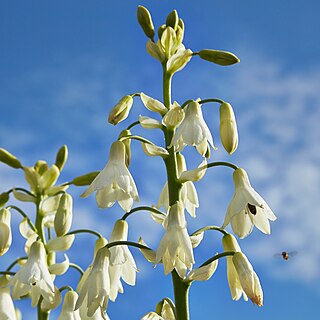
Oidium is a genus of Deuteromycetes, where traditionally most anamorphs of the order Erysiphales are included. Most of them are plant pathogens causing different forms of powdery mildew, for example:
Abuta candicans is a species in the Menispermaceae family.

Echium candicans, commonly known as pride of Madeira, is a species of flowering plant in the family Boraginaceae, native to the island of Madeira. It is a large herbaceous perennial subshrub, growing to 1.5–2.5 m.

The white-winged nightjar is a species of nightjar in the family Caprimulgidae native to Bolivia, Brazil and Paraguay, where it lives in open grassland with scattered trees. It is about 20 cm (8 in) long and sexually dimorphic, with females being slightly larger than males. It is usually a silent bird, but the male calls during courtship. It breeds in the summer, with the female incubating the eggs and rearing the young. It has a wide range but the population is declining, probably because of a decrease of suitable habitat, so the International Union for Conservation of Nature has assessed its conservation status as being "endangered".
Grevillea candicans is a shrub which is endemic to the south-west of Western Australia. It usually grows to between 1 and 5 metres in height and produces white or cream flowers between August and October in its native range.
Monardella candicans is a species of flowering plant in the mint family known by the common name Sierra monardella.

Echinopsis candicans is a species of cactus from northern and western Argentina. It has large fragrant white flowers that open at night.

Ornithogalum candicans, known as the summer hyacinth, is a species of flowering plant in the family Asparagaceae, native to moist grassland in South Africa. It is a bulbous perennial growing to 100–120 cm (39–47 in), with strap-shaped leaves and white snowdrop-like flowers in late summer. It is still widely referenced under its synonym Galtonia candicans. Originally it had been designated as Hyacinthus candicans, by Baker in 1870.
Lepturgantes is a genus of beetles in the family Cerambycidae, containing the following species:
Forsteriini is a tribe of longhorn beetles of the Lamiinae subfamily.
Falsamblesthis is a genus of longhorn beetles of the subfamily Lamiinae, containing the following species:
Falsamblesthis gracilis is a species of beetle in the family Cerambycidae. It was described by Lameere in 1893. It is known from Venezuela.
Falsamblesthis ibiyara is a species of beetle in the family Cerambycidae. It was described by Marinoni in 1978. It is known from Brazil.
Falsamblesthis macilenta is a species of beetle in the family Cerambycidae. It was described by Gounelle in 1910. It is known from Ecuador.
Falsamblesthis microps is a species of beetle in the family Cerambycidae. It was described by Martins and Galileo in 1992. It is known from Venezuela.
Falsamblesthis pilula is a species of beetle in the family Cerambycidae. It was described by Galileo and Martins in 1987. It is known from Colombia.
Falsamblesthis seriepilosa is a species of beetle in the family Cerambycidae. It was described by Kirsch in 1889. It is known from Ecuador.
Falsamblesthis taeniata is a species of beetle in the family Cerambycidae. It was described by Belon in 1903. It is known from Bolivia.
Falsamblesthis unguicularis is a species of beetle in the family Cerambycidae. It was described by Tippmann in 1960. It is known from Bolivia.
Callicarpa candicans is a species of flowering plant in the mint family.






